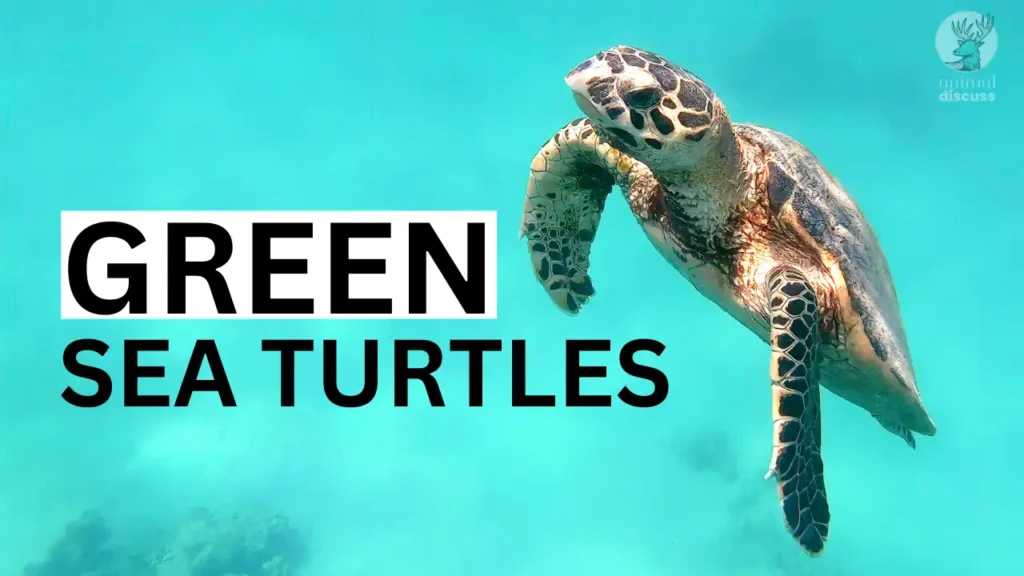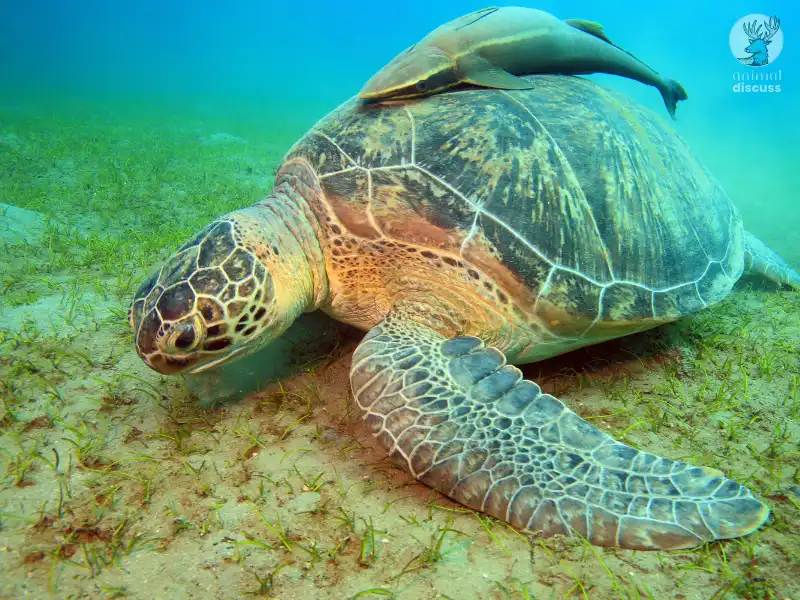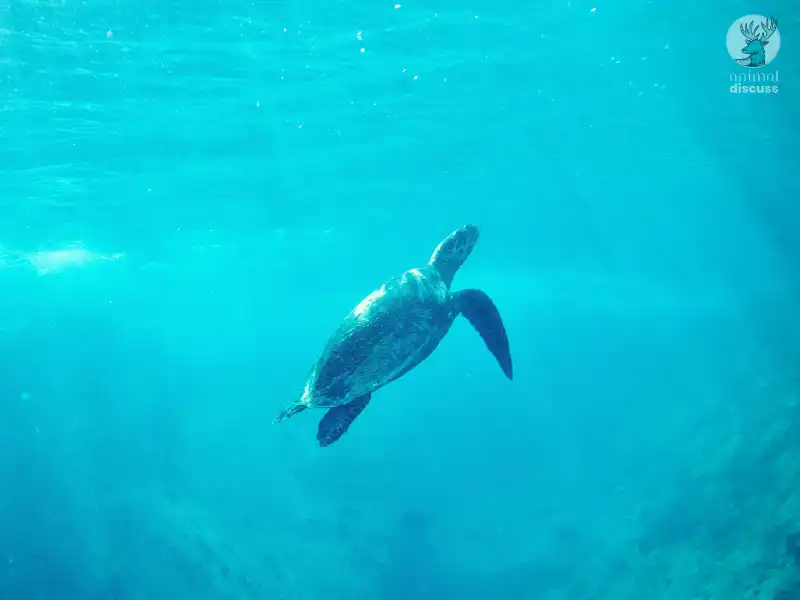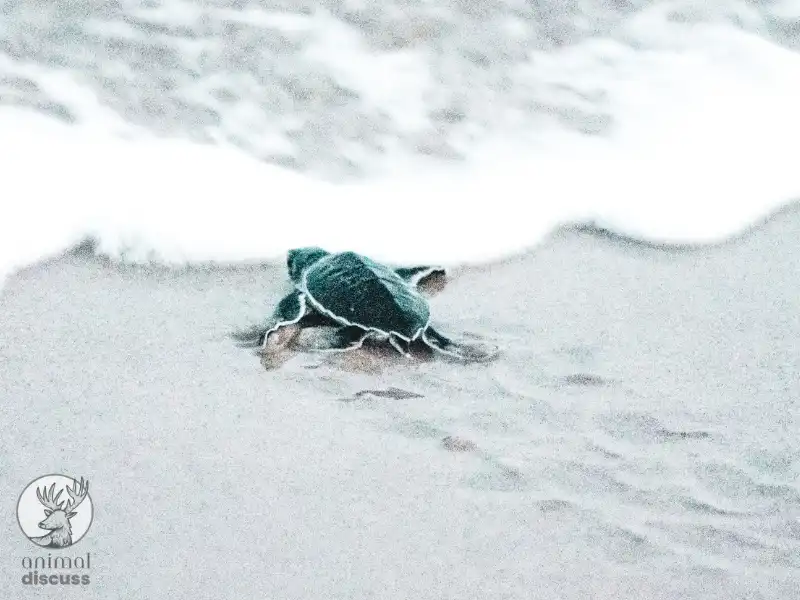Have you ever wondered about the Green Sea Turtle? The Green Sea Turtles are the friendly giant of the sea. They mesmerize everyone with their unique features.
Green Sea Turtles are different from other turtles because of their herbivorous diet, large size, migratory system, and temperature-dependent sex determination. They show amazing behavioral patterns. These turtles are very important for marine ecosystems.
In this article, I have mentioned their habitats, behaviors, and conservation status. I have also discussed their diets, nesting habits, and migrations. Let’s learn more-
What Are the Unique Features of Green Sea Turtles? [Reference]
Green Sea Turtles have some distinguished characteristics among other turtles in the world. Let’s have a quick review of their distinctive features –
| Characteristics | Description |
|---|---|
| Common name | Green Sea Turtle |
| Scientific name | Chelonia mydas |
| Family name | Cheloniidae |
| Number of Species | One |
| Population | 85,000-90,000 |
| Length | 36-48 inches |
| Carapace Width | 27-36 inches |
| Height | 14-19 inches |
| Weight | 240-420 Pounds |
| Coloration | Green or a blend of olive, gray, or black |
| Head | Rounded |
| Tail | Short |
| Lifespan | 70> years |
| Habitat | Subtropical and tropical ocean waters |
| Diet | Herbivores |
| Mating Life | Courtship |
| Communication | Body movement and chemical signals |
| Conservation status | Endangered |
Green Sea Turtles are the largest species of sea turtles. Although we know them as green turtles, their skin is not green. They are referred to as green because of the greenish fat they get from plants.
These turtles are bigger, and their carapace (upper shell) is a bit smaller with a length of 27 to 36 inches and a height of 14 to 19 inches.

The weight of Green Sea Turtles varies between 240 and 420 pounds. Their color patterns may differ, being green to dark brown or olive green to black. They have a round head, short tail, and a separate look that can easily be recognized.
These turtle species mostly reside in the subtropical and tropical ocean waters. They’re good travelers and they can migrate thousands of miles from their feeding area to the nesting place. They can live more than 70 years.
Again, Green Sea Turtles are herbivores predominantly feeding on sea grasses and algae. They are important for ocean health as they eat seagrass to keep underwater ecosystems in balance. However, the Green Sea Turtle species has been designated as endangered.
Where do Green Sea Turtles Live? [Reference]
Green sea turtles are to be found in the warm subtropical and tropical ocean waters around the world. Mainly, they stay close to the coast, preferring islands.
You can find these turtles in sandy shores, lagoons, and bays, particularly in regions with seagrass beds. They do not spend much time in the deep sea and generally, prefer to dwell in coastal areas.

One of the vital characteristics of their habitat is the presence of seagrass beds because it is an important feeding area for green sea turtles. They also prefer to nest on beaches. Such nesting sites are usually located near unexplored and undisturbed areas.
As a whole, the green sea turtle habitat is crucial to their survivorship and breeding. Protecting the coastal and marine habitats is needed for these animals’ existence.
Curious about their habitat? Check out this article to learn more about Green Sea Turtles’ habitat “Grab the ideas where green sea turtles live”.
What Are the Behavioral Facts of Green Sea Turtles? [Reference]
The behavior of Green Sea Turtles represents an exciting view of their life. These turtles have exceptional migratory skills. They cover thousands of miles accurately and straightforwardly.
Apart from that, these turtles have a unique behavior of spending time in the sunshine on the beach and rocky shores. This behavior is used for body temperature regulation and essential UV radiation absorption.
On the other hand, Green Sea Turtles are believed not to be highly social creatures. However, they perform communal behavior in some cases because these turtles share food areas and basking spots with other turtles.
Accordingly, during the mating season, male turtles perform a variety of complex courtship behaviors in a bid to attract females. These interconnected behaviors show the resilience and adaptiveness of Green Sea Turtles. It helps to sustain them in the evolving marine environment.
Curious about their behavior? Check out this article to learn more about Green Sea Turtles’ behavior.
How Do Green Sea Turtles Communicate? [Reference 1] [Reference 2]
Ever wondered about how Green Sea Turtle communicates? Well, they communicate in several ways.
One way where Green Sea Turtles communicate is through their body language. They communicate by incorporating swimming patterns such as head movement and flipper gestures.

For instance, during mating rituals, males may draw females by swimming in a specific pattern or by certain body movements.
Another way of communication is by reading non-verbal cues because Green Sea Turtles can see both underwater and on the water’s surface efficiently. They communicate visually through body posture, eye-to-eye, and color change with other turtles.
Take for example, when turtles are faced with an aggressive encounter, they may display threatening behaviors that can dissuade their rivals. Such communication is also assisted by chemical signals among the green sea turtles.
Like other animals, green sea turtles use pheromones and other chemical cues. These chemical signals include E2 (estradiol), Pro (progesterone), T (testosterone), and corticosterone, etc. hormones. These hormones transmit signals of aggression, reproductive readiness, and health.
In sum, these turtle species use various motion techniques, signals, and chemical signs to interact with other turtles.
What Do Green Sea Turtles Eat?
Want to know what Green Sea Turtles eat? The Green Sea Turtles have a unique diet. They are herbivorous! Undoubtedly, these turtles mainly live on plants from the sea, specifically, on seagrasses and algae.
They intake through their sharp serrated jaws which enable them to graze. While the juvenile green sea turtles become big, their diet becomes diverse. Young Turtles feed on things like mollusks, jellyfish, and even sponges in addition to their vegetarian diet.
Interestingly, the diet of green sea turtles can change slightly per location and the availability of their food. In locations where the seagrasses are rare, they could instead change their diets to algae.
Overall, the green sea turtles maintain a balance in marine ecosystems. Explore this article to discover more about their diet “Diving into the eating habits of Green Sea Turtles”.
How do Green Sea Turtles Reproduce? [Reference]
Now, let’s talk about their reproduction. Generally, during late spring and early summer, green sea turtle males gather along the shore to attract females. Once a female finds a suitable nesting site on a sandy beach, she creates a nest hole by digging it deep.
Then, she puts all the eggs in it. Its regular clutch consists of 75-200 eggs. After an incubation period of around two months, the eggs hatch, and the hatchlings come out of the nest.
One interesting thing about their reproduction is that baby green turtles’ gender depends on nest temperature. Female turtles hatch from warmer nests and the male ones from the cooler ones.
As soon as the hatchlings emerge from the nest, they instinctively head toward the ocean. Consequently, these turtles start paddling with their flippers and ride to find safety in the waters.
Why Are Green Sea Turtles Important? [Reference]
Green sea turtles are important players in the marine ecosystems’ food web. They graze on seagrass beds and coral reefs. This practice is beneficial to promote the growth of new grass and prevent overgrowth.
That’s how they create suitable habitats for numerous species of marine life. Besides, Green Sea Turtles perform as ecosystem health and biodiversity indicators. This makes them critical for the conservation of the coastal ecosystems.
What Threats Do Green Sea Turtles Face?
Do you know these turtles are facing some serious challenges? Yes, according to the International Union for Conservation of Nature (IUCN), the Green Sea Turtles fall into the Endangered category. They are in a worse situation and need our assistance to survive.

But have you ever thought why are Green Sea Turtles becoming endangered? Well, we humans are the main reason. Previously, they were consumed for their meat, eggs, and shells. As a result, their populations were reduced by a very two-thirds overall.
Additionally, coastal development, pollution, and climate change ruin their habitats. Coastal development destroys nesting beaches and feeding grounds where they live.
Then, pollution from human activities increases harmful substances such as plastic debris, in their environment. Lastly, climate change reduces nests and food resources.
What Are the Conservation Strategies for Green Sea Turtles?
Eager to know about their conservation strategies? Green Sea Turtles need several strategies that will tackle threats to their existence. First, the protection of habitat is indispensable. The creation of marine protected areas is a must to preserve vital habitats.
Also, nesting sites should be managed to decrease disturbance and improve hatchling survival rates. Moreover, using turtle excluder devices minimizes accidental catch.
Finally, community engagement is a key factor for turtle conservation awareness. A successful conservation program helps to safeguard the lives of these magnificent creatures and their habitats.
Frequently Asked Questions
Do you want to know more about them? The following list of frequently asked questions will provide additional information about green sea turtles-
What is the special body part of the Green Sea Turtle?
Paddle-like limbs known as flippers are their special body part. It helps their quick body movements.
Where do Green Sea Turtles sleep?
These Sea turtles sleep at the surface of the sea. Divers found Green Sea Turtles sleeping under ledges in reefs and rocky areas.
How many hours do Green Sea Turtles sleep?
These Sea turtles sleep around 11 hours a day.
Conclusion
In summary, the Green Sea Turtle is an interesting marine reptile. They have unique features, behavioral patterns, and ecological values. The unique physical characteristics, migration, and nesting of these turtles make their conservation a global priority.
Still, they face threats like habitat loss, pollution, and climate change. By ensuring habitat safety, nesting site creation, and collaborative influence, we can save the species of Green Sea Turtle.

